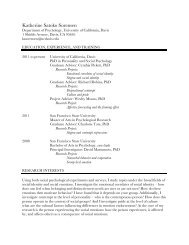The Psychology of Creativity:
The Psychology of Creativity:
The Psychology of Creativity:
Create successful ePaper yourself
Turn your PDF publications into a flip-book with our unique Google optimized e-Paper software.
History <strong>of</strong> <strong>Creativity</strong> Research 19<br />
computer simulations also inspired case studies <strong>of</strong> creative episodes in the lives <strong>of</strong> historic geniuses. Each <strong>of</strong> these<br />
developments deserve at least a brief look.<br />
Problem-solving experiments. I already noted that Gestalt psychologists introduced the insight process into<br />
the experimental study <strong>of</strong> creativity. Cognitive psychologists have built upon this early tradition by developing new<br />
experimental methodologies and theoretical models (Sternberg & Davidson, 1995). By manipulating priming<br />
stimuli, assessing “feeling-<strong>of</strong>-knowing” states, and applying other techniques, psychologists have obtained a better<br />
appreciation for how creative insights emerge during the incubation period. Especially provocative is the empirical<br />
demonstration <strong>of</strong> intuitive information processing as a regular manifestation <strong>of</strong> the “cognitive unconscious” (e.g.,<br />
Bowers, Farvolden, & Mermigis, 1995; Schooler & Melcher, 1995). <strong>The</strong> magic behind the sudden, unexpected, and<br />
seemingly unprepared inspiration has now been replaced by the lawful operation <strong>of</strong> basic processes like “subliminal<br />
stimulation” and “spreading activation.”<br />
<strong>The</strong> last decade <strong>of</strong> the 20th century saw the emergence <strong>of</strong> the “creative cognition approach” (Smith, Ward,<br />
& Finke, 1995). According to this research program, creativity is a mental phenomenon that results from the<br />
application <strong>of</strong> ordinary cognitive processes (see also Ward, Smith, & Vaid, 1997). In addition, just as laboratory<br />
experiments have provided tremendous insights into human cognition, so can the same methodology be applied to<br />
the study <strong>of</strong> creative thought. Particularly fascinating are the experimental studies showing how visual imagery can<br />
function in the origination <strong>of</strong> creative ideas (Finke, Ward, & Smith, 1992). Another exciting feature <strong>of</strong> these<br />
experiments is the use <strong>of</strong> open-ended problems that demand genuine creativity, in contrast to much laboratory<br />
research that relies on problems that have fixed solutions. Nevertheless, these investigations concur with those on<br />
insightful problem-solving in one fundamental message: To a very large extent, creativity entails ordinary cognitive<br />
processes. Indeed, some cognitive psychologists would go so far as to say that outstanding creators, even an<br />
outright creative genius, has done nothing more than acquire exceptional expertise in a given domain (Ericsson,<br />
1996; but see Simonton, 2000a).<br />
Computer simulations. <strong>The</strong> computer metaphor is pervasive in cognitive psychology, so much so that<br />
theories are <strong>of</strong>ten expressed as computer rather than mathematical models. Given this trend, it should come as no<br />
surprise that computers have become increasingly used to test cognitive models <strong>of</strong> the creative process (Boden,<br />
1991; Johnson-Laird, 1993). For instance, Newell and Simon’s (1972) influential theory <strong>of</strong> human problem solving<br />
has inspired the emergence <strong>of</strong> several “discovery programs” that purport to uncover laws and principles from
















